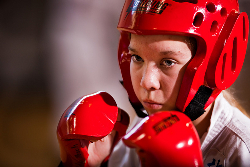2020 February
2018 December August June February
2017 December September June March
2016 November August June March
2015 December October July May February
2014 December October July April February
2013 December October August May February
2012 December September July April February
2011 December September July April February
from the November, 2010 issue of Kiai!
Sparring for Kids: What's It All About?
By Jun Shihan Nancy and Kyoshi Sarah
Seido karate includes four distinct areas of training: basic technique, kata (forms), kumite (sparring) and self-defense. Each part contributes something unique and valuable to our child members’ development. For this reason, we require members to engage in ALL parts of the art as they advance through the ranks, rather than picking and choosing the ones they prefer. The following questions and answers will explain the purpose and value of sparring for children, including when and how this key part of Seido karate is taught here at Thousand Waves.
 What is sparring?
What is sparring?
Sparring is the unchoreographed, sportive exchange of techniques by two karate practitioners. It is governed by rules, rituals, and etiquette that make it physically and emotionally safe and empowering.
What is pre-sparring?
Pre-sparring refers to a highly developed teaching methodology we have at Thousand Waves to prepare newer students for the more advanced activity of sparring. Skills taught include the use and care for protective equipment; legal and illegal targets and techniques, effective offensive combinations; defensive strategies such as blocking and evasion and communication/behavioral skills required for safe partnering.
Is sparring safe?
Yes! Although accidents can and do (rarely) happen, the rate of injury in pre-sparring and sparring activities is no higher than in any other part of karate practice. The required safety equipment of a mouthguard, hand and feet pads and a helmet protects both the wearer and their partners.
Why do we teach sparring?
Sparring is karate in action—the opportunity to apply techniques and strategies in spontaneous situations. It develops mobility, aim, distancing and control, and also builds endurance. We teach it to build courage and spirit in our students and to provide opportunities for them to study how they react under pressure. Students who are initially nervous or afraid learn that by persevering, fears can be overcome. We believe that this may well help them take on other life challenges that scare them and see that they can do more than they thought they could.
When will my child engage in pre-sparring and sparring and what do they need to have?
We do not teach sparring in the Junior program. Students in the Youth program begin pre-sparring at yellow belt. Teens start pre-sparring at blue belt. Both Youth and Teens graduate to free-sparring at green belt.
 The 4:30 PM Youth/Teen classes on Tuesdays and Thursdays are devoted to pre- and free-sparring. A teen-only pre-sparring/free-sparring class is offered on Thursday at 5:30 PM. And teens are welcome in the two adult pre-sparring classes, which are Tuesday at 6:30 PM and Sunday at Noon. Eligible students should take one sparring skills class per week.
The 4:30 PM Youth/Teen classes on Tuesdays and Thursdays are devoted to pre- and free-sparring. A teen-only pre-sparring/free-sparring class is offered on Thursday at 5:30 PM. And teens are welcome in the two adult pre-sparring classes, which are Tuesday at 6:30 PM and Sunday at Noon. Eligible students should take one sparring skills class per week.
We require that the children wear head/hands/feet safeties as well as a mouthguard. They need to have their own mouthguard and case. Additionally, boys (green belt and above) are required to wear a groin cup for free-sparring. We have a limited amount of head/hands/feet safeties for your child to borrow until you can purchase gear for them. If you buy the safeties all at once we include a FREE training bag.
What should I do if my child is afraid of or doesn’t like sparring?
Talk to us and we will talk with your child to understand what your child is feeling. We will validate their feelings and encourage them to keep trying. We will also help them learn how to speak up and set limits with their partners about what they need to feel safe and respected. And we will talk with the teachers to be sure your child receives the personal support he or she might need. Sparring takes time to learn but if students are patient and attend sparring class regularly, they will improve and may even come to enjoy this part of training.
